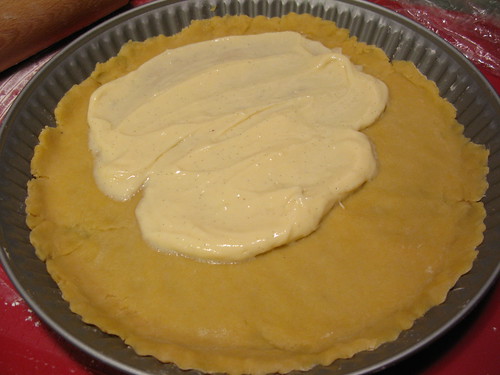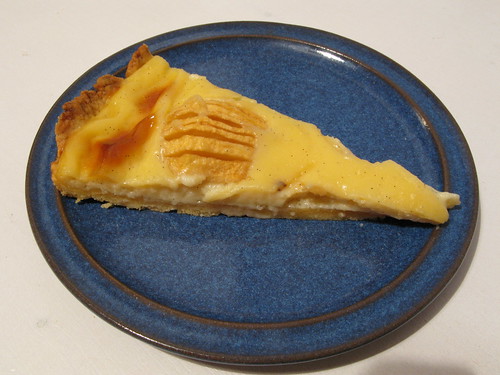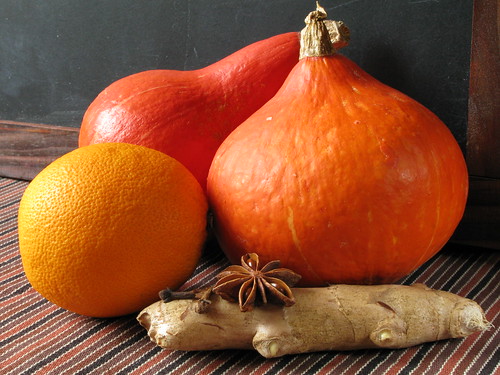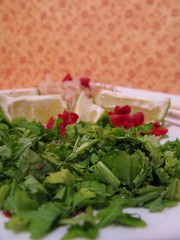The September 2009 Daring Bakers' challenge was hosted by Steph of A Whisk and a Spoon. She chose the French treat, Vols-au-Vent based on the Puff Pastry recipe by Michel Richard from the cookbook Baking With Julia by Dorie Greenspan.
I knew this day would come. I knew there would be a time when I had to try a puff pastry myself, but I didn't know it would be that soon ... Roberts first comment on that issue: "Do we have some earplugs so that I don't need to hear your screaming from the kitchen?". Yeahh, I felt like screaming - how am I gonna to do
that? Somehow I managed it at the end ... I found out that I just needed patience (and I don't own much of it which was the real challenge for me). I used 2/3 of the remaining dough for a tart with the chicken-filling (mixed with an egg and coverd with cheese) and 1/3 for a completely self-made banana tarte tatin (adapted from
here, used my self-made caramel-sauce instead). The tarte tatin was incredible and I was in dessert heaven. Thank you Steph for making me try, the tarte was a hundred times worth it!
 Michel Richard's Puff Pastry Dough
Michel Richard's Puff Pastry Dough
From: Baking with Julia by Dorie Greenspan
Yield: 2-1/2 pounds dough
There is a wonderful
on-line video from the PBS show "Baking with Julia" that accompanies the book. In it, Michel Richard and Julia Child demonstrate making puff pastry dough (although they go on to use it in other applications). They do seem to give slightly different ingredient measurements verbally than the ones in the book…I listed the recipe as it appears printed in the book.
Ingredients:
(1/3 of the puff pastry recipe will yield about 8-10 3,8 cm Ø vols-au-vent or 4 10,2 cm Ø vols-au-vent)
- 2-1/2 cups (12.2 oz/ 354 g) unbleached all-purpose flour
- 1-1/4 cups (5.0 oz/ 142 g) cake flour
- 1 tbsp. salt (you can cut this by half for a less salty dough or for sweet preparations)
- 1-1/4 cups (10 fl oz/ 300 ml) ice water
- 1 pound (16 oz/ 454 g) very cold unsalted butter
- plus extra flour for dusting work surface
Mixing the Dough:
Check the capacity of your food processor before you start. If it cannot hold the full quantity of ingredients, make the dough into two batches and combine them. Put the all-purpose flour, cake flour, and salt in the work bowl of a food processor fitted with a metal blade and pulse a couple of times just to mix. Add the water all at once, pulsing until the dough forms a ball on the blade. The dough will be very moist and pliable and will hold together when squeezed between your fingers. (Actually, it will feel like Play-Doh.) Remove the dough from the machine, form it into a ball, with a small sharp knife, slash the top in a tic-tac-toe pattern. Wrap the dough in a damp towel and refrigerate for about 5 minutes.
Meanwhile, place the butter between 2 sheets of plastic wrap and beat it with a rolling pin until it flattens into a square that's about 1" (2,5 cm) thick. Take care that the butter remains cool and firm: if it has softened or become oily, chill it before continuing.
Incorporating the butter:
Unwrap the dough and place it on a work surface dusted with all-purpose flour (A cool piece of marble is the ideal surface for puff pastry) with your rolling pin (preferably a French rolling pin without handles), press on the dough to flatten it and then roll it into a 10" (25 cm) square. Keep the top and bottom of the dough well floured to prevent sticking and lift the dough and move it around frequently. Starting from the center of the square, roll out over each corner to create a thick center pad with "ears," or flaps.
Place the cold butter in the middle of the dough and fold the ears over the butter, stretching them as needed so that they overlap slightly and encase the butter completely. (If you have to stretch the dough, stretch it from all over; don't just pull the ends) you should now have a package that is 8'' (20cm) square.
To make great puff pastry, it is important to keep the dough cold at all times. There are specified times for chilling the dough, but if your room is warm, or you work slowly, or you find that for no particular reason the butter starts to ooze out of the pastry, cover the dough with plastic wrap and refrigerate it . You can stop at any point in the process and continue at your convenience or when the dough is properly chilled.
Making the Turns:
Gently but firmly press the rolling pin against the top and bottom edges of the square (this will help keep it square). Then, keeping the work surface and the top of the dough well floured to prevent sticking, roll the dough into a rectangle that is three times as long as the square you started with, about 24" (61 cm) (don't worry about the width of the rectangle: if you get the 24", everything else will work itself out.) With this first roll, it is particularly important that the butter be rolled evenly along the length and width of the rectangle; check when you start rolling that the butter is moving along well, and roll a bit harder or more evenly, if necessary, to get a smooth, even dough-butter sandwich (use your arm-strength!).
With a pastry brush, brush off the excess flour from the top of the dough, and fold the rectangle up from the bottom and down from the top in thirds, like a business letter, brushing off the excess flour. You have completed one turn.
Rotate the dough so that the closed fold is to your left, like the spine of a book. Repeat the rolling and folding process, rolling the dough to a length of 24" and then folding it in thirds. This is the second turn.
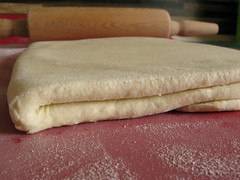

Chilling the Dough:
If the dough is still cool and no butter is oozing out, you can give the dough another two turns now. If the condition of the dough is iffy, wrap it in plastic wrap and refrigerate it for at least 30 minutes. Each time you refrigerate the dough, mark the number of turns you've completed by indenting the dough with your fingertips. It is best to refrigerate the dough for 30 to 60 minutes between each set of two turns.
The total number of turns needed is six. If you prefer, you can give the dough just four turns now, chill it overnight, and do the last two turns the next day. Puff pastry is extremely flexible in this regard. However, no matter how you arrange your schedule, you should plan to chill the dough for at least an hour before cutting or shaping it.
Making the vols-au-vent
In addition you will need:
- egg wash (1 egg or yolk beaten with a small amount of water)
- your filling of choice (mine see recipe below)
Smoked-chicken-bell pepper-leek-filling
- meat of one smoked chicken leg, cut into small pieces
- one leek, divided in halves and cut in stripes
- 5 small filled hot pepper bells in oil
- 1 pepper bell, diced
- 125 g sour cream
- 125 g joghurt
- salt & pepper
Line a baking sheet with parchment and set aside.
Using a knife or metal bench scraper, divided your chilled puff pastry dough into three equal pieces. Work with one piece of the dough, and leave the rest wrapped and chilled. (If you are looking to make more vols-au-vent than the yield stated above, you can roll and cut the remaining two pieces of dough as well…if not, then leave refrigerated for the time being or prepare it for longer-term freezer storage. See the "Tips" section below for more storage info.)
On a lightly floured surface, roll the piece of dough into a rectangle about 1/8 to 1/4-inch (3-6 mm) thick. Transfer it to the baking sheet and refrigerate for about 10 minutes before proceeding with the cutting.
(This assumes you will be using round cutters, but if you do not have them, it is possible to cut square vols-au-vents using a sharp chef's knife.) Using a ¾-inch cutter for small vols-au-vent, or a 2- to 2.5-inch round cutter for large, cut centers from half of the rounds to make rings. These rings will become the sides of the vols-au-vent, while the solid disks will be the bottoms. You can either save the center cut-outs to bake off as little "caps" for you vols-au-vent, or put them in the scrap pile.
Dock the solid bottom rounds with a fork (prick them lightly, making sure not to go all the way through the pastry) and lightly brush them with egg wash. Place the rings directly on top of the bottom rounds and very lightly press them to adhere. Brush the top rings lightly with egg wash, trying not to drip any down the sides (which may inhibit rise). If you are using the little "caps," dock and egg wash them as well.
Refrigerate the assembled vols-au-vent on the lined baking sheet while you pre-heat the oven to 400ºF (200ºC). (You could also cover and refrigerate them for a few hours at this point.)
Once the oven is heated, remove the sheet from the refrigerator and place a silicon baking mat (preferred because of its weight) or another sheet of parchment over top of the shells. This will help them rise evenly. Bake the shells until they have risen and begin to brown, about 10-15 minutes depending on their size. Reduce the oven temperature to 350ºF (180ºC), and remove the silicon mat or parchment sheet from the top of the vols-au-vent. If the centers have risen up inside the vols-au-vent, you can gently press them down. Continue baking (with no sheet on top) until the layers are golden, about 15-20 minutes more. (If you are baking the center "caps" they will likely be finished well ahead of the shells, so keep an eye on them and remove them from the oven when browned.)
Remove to a rack to cool. Cool to room temperature for cold fillings or to warm for hot fillings.
For the filling mix sour cream, joghurt, 2 tblsp of the hot pepper bell oil and the hot pepper bell filling. Season with salt and pepper. Add the chicken, leek and diced pepper bells. Fill into the vols-au-vents and enjoy.
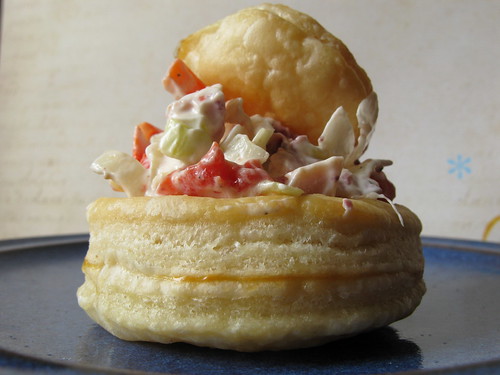
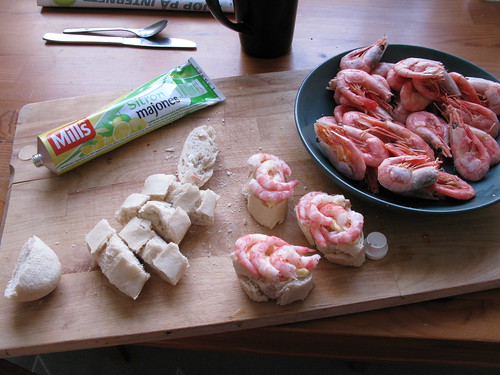
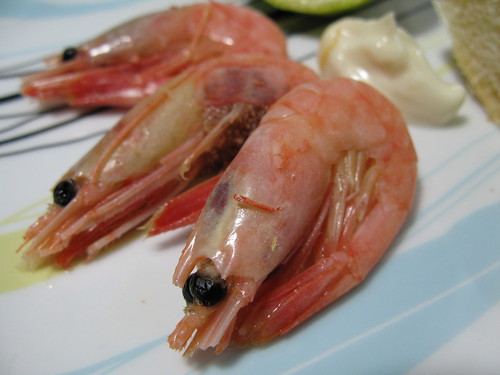
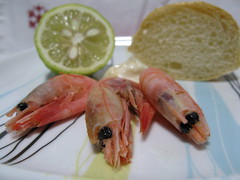
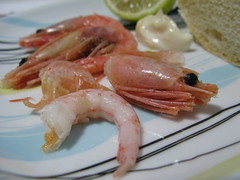
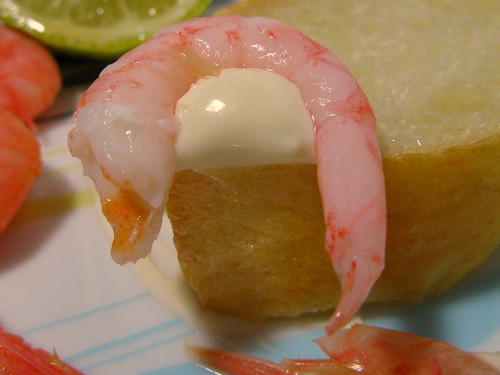









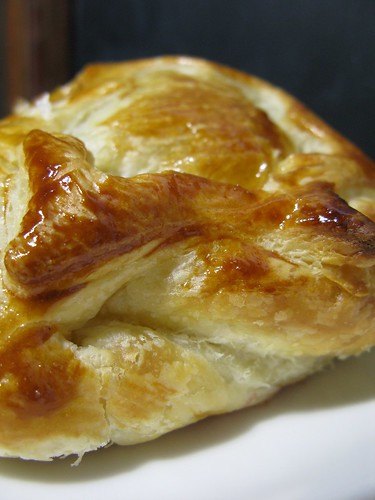
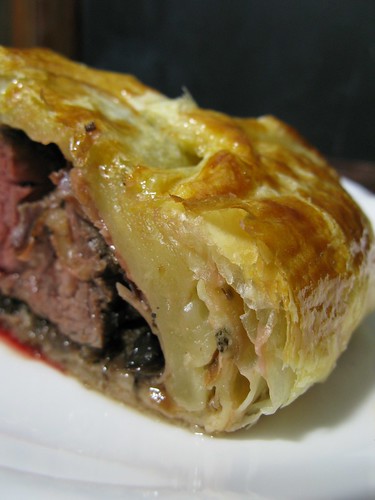


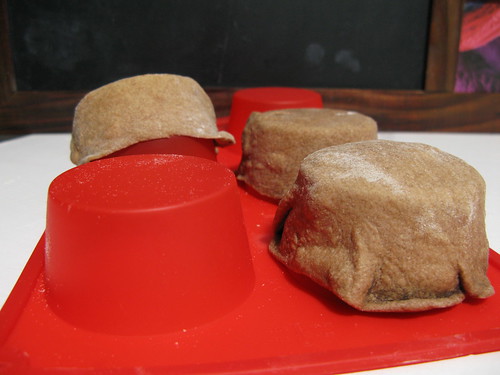


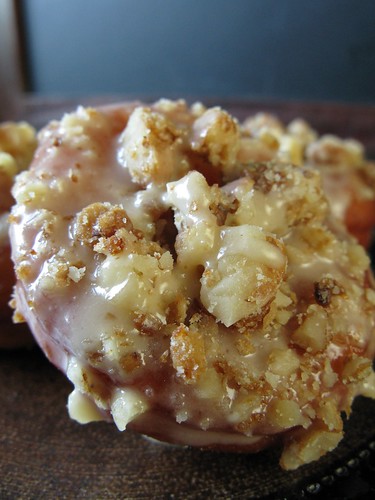 Für die "Streusel" die Walnüsse in einer Pfanne anrösten. Den Sirup dazugeben und gut verteilen. Bei mittlerer Hitze karamellisieren lassen bis alles von den Nüssen 'aufgesogen' ist. Auf einem mit Backpapier ausgelegtem Blech verteilen und erkalten lassen. Mit Hilfe einer Pfanne oder Nudelholzes in kleine Stücke hacken. Den Puderzucker portionsweise mit dem Ahornsirup mischen bis die Glasur eine dickflüssige Konsistenz hat. Dann auf den Donuts verteilen und mit den "Streuseln" bestreuen.
Für die "Streusel" die Walnüsse in einer Pfanne anrösten. Den Sirup dazugeben und gut verteilen. Bei mittlerer Hitze karamellisieren lassen bis alles von den Nüssen 'aufgesogen' ist. Auf einem mit Backpapier ausgelegtem Blech verteilen und erkalten lassen. Mit Hilfe einer Pfanne oder Nudelholzes in kleine Stücke hacken. Den Puderzucker portionsweise mit dem Ahornsirup mischen bis die Glasur eine dickflüssige Konsistenz hat. Dann auf den Donuts verteilen und mit den "Streuseln" bestreuen.

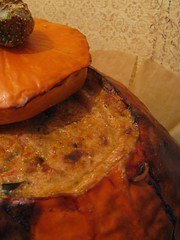


 1 sheet 7"x8" (17.5cmx20cm) of toasted nori (dried seaweed sheets), cut into halves
1 sheet 7"x8" (17.5cmx20cm) of toasted nori (dried seaweed sheets), cut into halves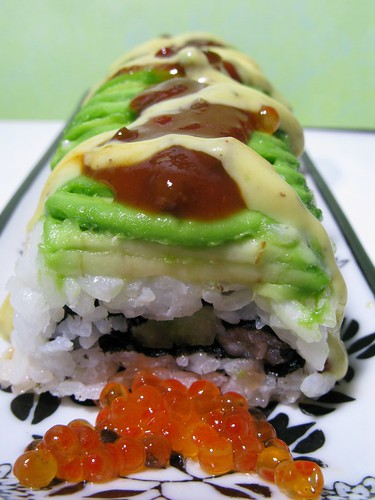
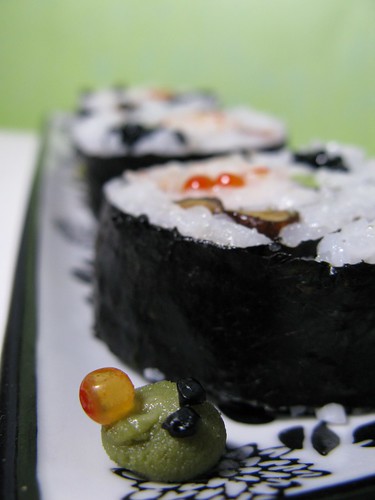
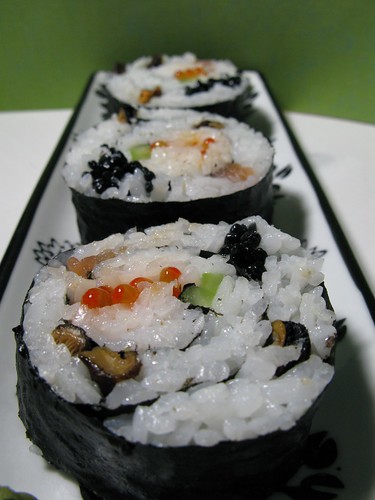
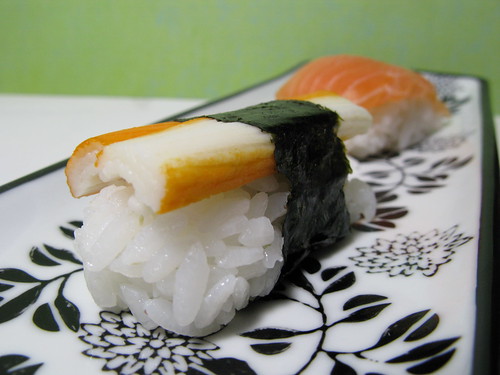

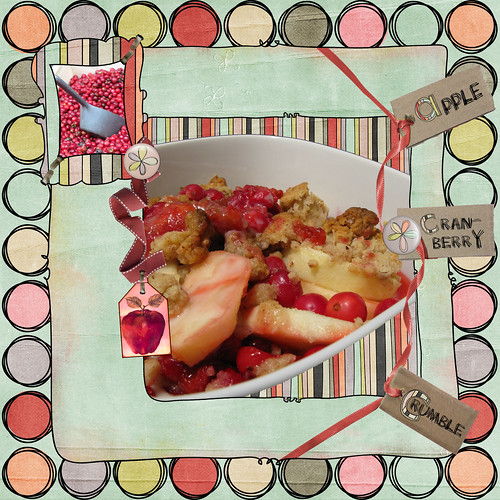


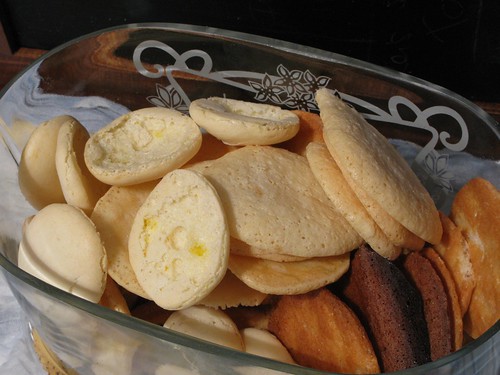
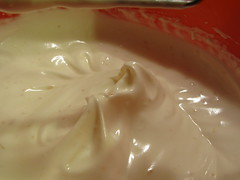

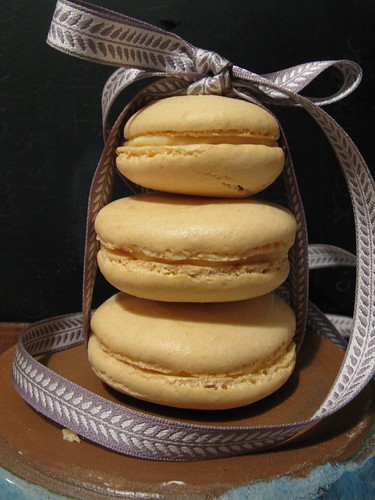
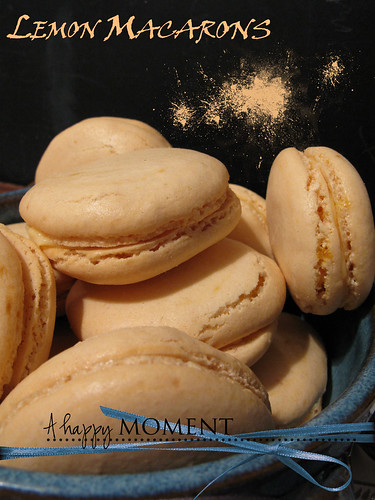 There is just one last question: What am I going to do with the ten remaining egg yolks ???
There is just one last question: What am I going to do with the ten remaining egg yolks ???

